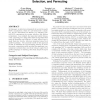Free Online Productivity Tools
i2Speak
i2Symbol
i2OCR
iTex2Img
iWeb2Print
iWeb2Shot
i2Type
iPdf2Split
iPdf2Merge
i2Bopomofo
i2Arabic
i2Style
i2Image
i2PDF
iLatex2Rtf
Sci2ools
107
Voted
CCS
2010
ACM
2010
ACM
Bureaucratic protocols for secure two-party sorting, selection, and permuting
In this paper, we introduce a framework for secure two-party (S2P) computations, which we call bureaucratic computing, and we demonstrate its efficiency by designing practical S2P computations for sorting, selection, and random permutation. In a nutshell, the main idea behind bureaucratic computing is to design data-oblivious algorithms that push all knowledge and influence of input values down to small black-box circuits, which are simulated using Yao’s garbled paradigm. The practical benefit of this approach is that it maintains the zero-knowledge features of secure two-party computations while avoiding the significant computational overheads that come from trying to apply Yao’s garbled paradigm to anything other than simple two-input functions. 1 Categories and Subject Descriptors K.6 [Management of Computing and Information Systems]: Miscellaneous General Terms Algorithms, Security Keywords Secure two-party computation, sorting, oblivious algorithms, bureaucratic protocols
Bureaucratic Computing | CCS 2010 | Secure Two-party Computation | Security Privacy | Yao’s Garbled Paradigm |
| Added | 18 May 2010 |
| Updated | 18 May 2010 |
| Type | Conference |
| Year | 2010 |
| Where | CCS |
| Authors | Guan Wang, Tongbo Luo, Michael T. Goodrich, Wenliang Du, Zutao Zhu |
Comments (0)

